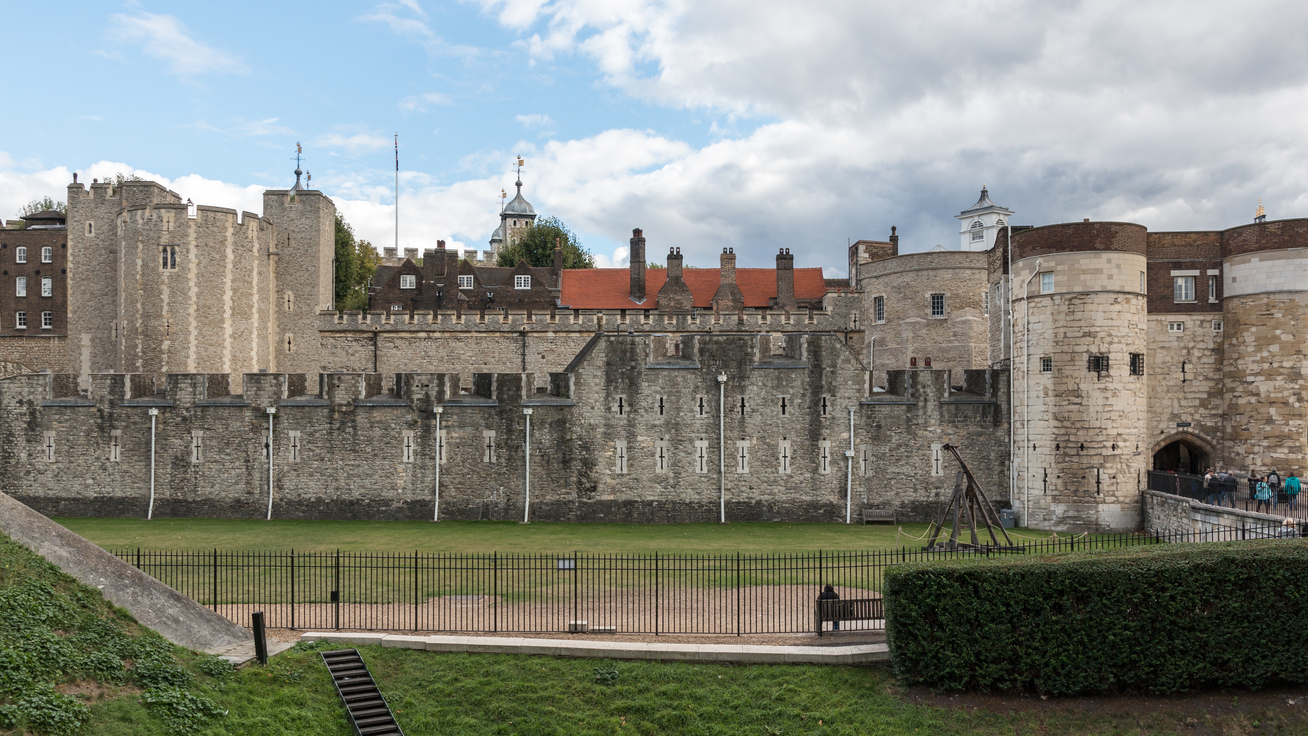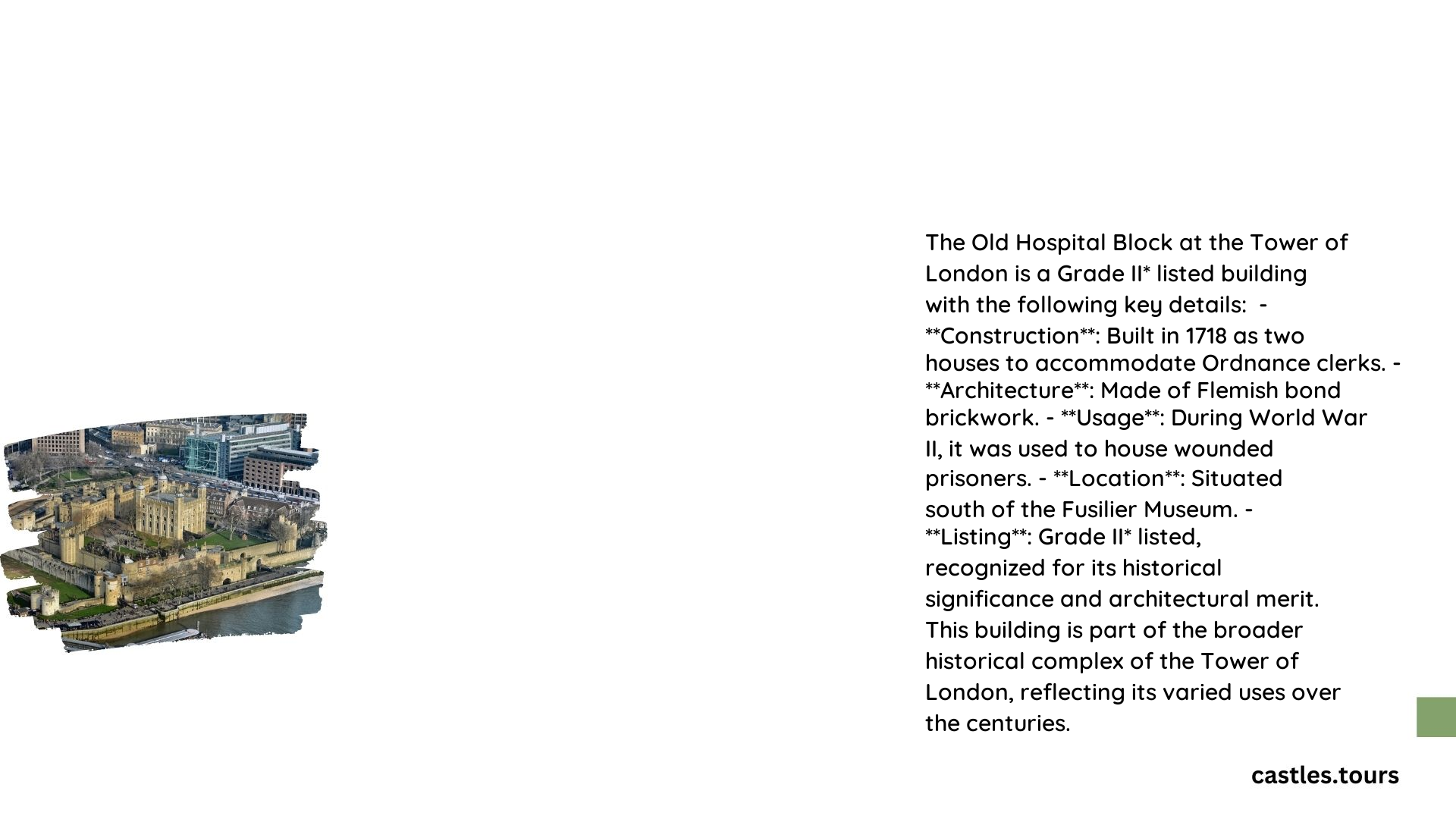The Tower of London Old Hospital Block, constructed in 1718, stands as a testament to the evolving history of this iconic fortress. Originally built as housing for Board of Ordnance clerks, it later served as a hospital before becoming residential quarters for Yeoman Warders. Its Flemish bond brickwork and strategic location within the inner ward highlight its architectural and historical significance. The building exemplifies the Tower’s adaptation over centuries, transitioning from a royal fortress to a multifaceted complex serving various functions.
What is the Historical Significance of the Old Hospital Block?

The Old Hospital Block at the Tower of London holds immense historical importance due to its varied roles over the centuries:
- Initial Purpose: Constructed in 1718 as housing for Board of Ordnance clerks
- Conversion: Transformed into a hospital during the 18th century
- Modern Use: Now serves as residential accommodation for Yeoman Warders and staff
- Architectural Value: Features Flemish bond brickwork and period-typical materials
- Historical Context: Represents the Tower’s evolution from fortress to multifunctional complex
This building’s history reflects the broader changes in the Tower of London’s purpose and function over time, making it a crucial part of the site’s historical narrative.
How Was the Old Hospital Block Constructed?

The construction of the Old Hospital Block in 1718 involved specific architectural elements and materials:
- Brickwork: Flemish bond style, popular in the early 18th century
- Foundation: Mortared flint rubble
- Detailing: Limestone dressings
- Structure: Originally built as two separate houses
- Design: Typical of early 18th-century architectural styles
These construction details provide insight into the building practices and materials available during the early 18th century, offering a glimpse into the architectural history of the Tower of London.
What Changes Has the Old Hospital Block Undergone?
The Old Hospital Block has undergone several transformations since its construction:
- Initial Construction (1718): Built as housing for Board of Ordnance clerks
- Hospital Conversion (18th century): Repurposed to serve medical needs
- Cessation of Hospital Function (19th century): Ended its role as a medical facility
- Modern Adaptation: Converted to residential quarters for Yeoman Warders and staff
- Ongoing Maintenance: Regular upkeep to preserve its historical integrity
These changes reflect the Tower of London’s evolving needs and functions over the centuries, demonstrating the adaptability of its structures.
Where is the Old Hospital Block Located Within the Tower Complex?
The Old Hospital Block occupies a strategic position within the Tower of London:
- Location: Inner ward of the Tower complex
- Proximity: Near other significant structures like the White Tower and Chapel of St Peter ad Vincula
- Accessibility: Part of the general visitor route, though interior access may be limited
- Integration: Well-integrated into the overall layout of the Tower
- Historical Context: Surrounded by structures from various periods, contributing to the Tower’s layered history
This location underscores the Old Hospital Block’s importance within the Tower’s overall historical and architectural landscape.
Can Visitors Tour the Old Hospital Block?
While there isn’t a specific tour dedicated to the Old Hospital Block, visitors can experience it as part of their Tower of London visit:
| Aspect | Details |
|---|---|
| General Admission | Includes access to the inner ward where the Old Hospital Block is located |
| Opening Hours | Daily, with seasonal variations |
| Ticket Prices | Vary based on season and ticket type |
| Interior Access | Limited, as it serves as residential quarters |
| Guided Tours | Yeoman Warder tours cover the general area |
| Special Events | Ceremony of the Keys and other Tower events may pass by the building |
Visitors can appreciate the exterior of the Old Hospital Block and learn about its history through guided tours and information panels throughout the Tower complex.
What Makes the Old Hospital Block Unique Among Tower of London Structures?
The Old Hospital Block stands out among Tower of London structures for several reasons:
- Adaptive Reuse: One of the best examples of repurposed buildings within the complex
- Architectural Style: Represents early 18th-century design within a medieval fortress
- Continuous Occupation: Has been in use since its construction, adapting to changing needs
- Residential Function: Currently houses Yeoman Warders, maintaining a living connection to Tower traditions
- Historical Layers: Embodies multiple periods of the Tower’s history in one structure
These unique aspects make the Old Hospital Block a fascinating study in the Tower of London’s architectural and functional evolution over time.
How Does the Old Hospital Block Contribute to the Tower of London’s UNESCO World Heritage Status?
The Old Hospital Block plays a role in the Tower of London’s UNESCO World Heritage status:
- Historical Continuity: Demonstrates the site’s continuous use and adaptation
- Architectural Diversity: Adds to the range of architectural styles present at the Tower
- Cultural Significance: Contributes to the narrative of the Tower’s evolving functions
- Preservation of Heritage: Represents ongoing efforts to maintain historical structures
- Living History: As current Yeoman Warder housing, it connects past and present
By embodying these aspects, the Old Hospital Block supports the Tower of London’s status as a site of “Outstanding Universal Value” recognized by UNESCO.
References:
1. https://en.wikipedia.org/wiki/Tower_of_london
2. https://localhistories.org/a-history-of-the-tower-of-london/
3. https://www.heritagegateway.org.uk/Gateway/Results_Single.aspx?resourceID=19191
